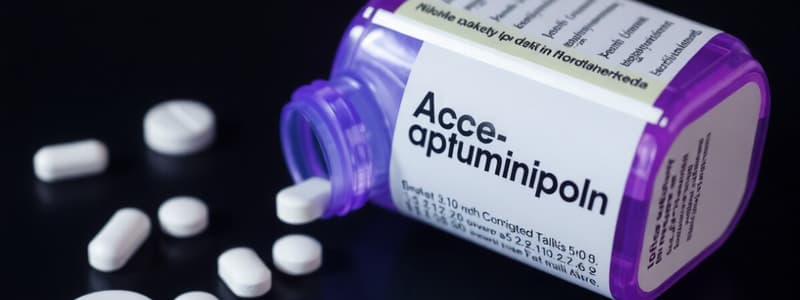Podcast
Questions and Answers
What is the maximum 24-hour dosage of acetaminophen for an adult without liver dysfunction?
What is the maximum 24-hour dosage of acetaminophen for an adult without liver dysfunction?
- 2 g
- 4 g
- 3 g (correct)
- 1 g
Which of the following is NOT a common indication for acetaminophen use?
Which of the following is NOT a common indication for acetaminophen use?
- Pyrexia
- Severe pain relief (correct)
- Mild to moderate pain
- Antipyresis
What mechanism does acetaminophen use to reduce symptoms?
What mechanism does acetaminophen use to reduce symptoms?
- Inhibits cyclooxygenase in peripheral tissues
- Enhances body temperature regulation
- Blocks nerve signal transmission
- Inhibits prostaglandin synthetase in the central nervous system (correct)
Which of the following conditions is a contraindication for acetaminophen use?
Which of the following conditions is a contraindication for acetaminophen use?
What is the recommended oral dosage for a pediatric patient weighing less than 30 kg?
What is the recommended oral dosage for a pediatric patient weighing less than 30 kg?
What are the potential adverse effects of long-term acetaminophen use?
What are the potential adverse effects of long-term acetaminophen use?
How quickly does intravenous acetaminophen typically reach its peak effect?
How quickly does intravenous acetaminophen typically reach its peak effect?
Which group is at the highest risk for acetaminophen toxicity?
Which group is at the highest risk for acetaminophen toxicity?
What is the correct dosing guidance for a pediatric patient weighing between 30-50 kg?
What is the correct dosing guidance for a pediatric patient weighing between 30-50 kg?
What is a common side effect associated with short-term use of acetaminophen?
What is a common side effect associated with short-term use of acetaminophen?
Flashcards
Acetaminophen
Acetaminophen
A common analgesic and antipyretic used for pain relief and fever reduction.
Analgesic
Analgesic
A classification of medications used to relieve pain.
Antipyretic
Antipyretic
A type of medication that reduces fever.
Adult Dosage
Adult Dosage
Signup and view all the flashcards
Pediatric Dosing
Pediatric Dosing
Signup and view all the flashcards
Mechanism of Action
Mechanism of Action
Signup and view all the flashcards
Adverse Effects
Adverse Effects
Signup and view all the flashcards
Overdose Risk
Overdose Risk
Signup and view all the flashcards
Contraindications
Contraindications
Signup and view all the flashcards
Pharmacokinetics
Pharmacokinetics
Signup and view all the flashcards
Study Notes
Acetaminophen: Overview
- Classification: Analgesic and Antipyretic
- Brand Names: Abenol®, Actimol®, Atasol®, Tylenol®
- Indications: Mild to moderate pain, and pyrexia (fever reduction)
Indications (Detailed)
- EMR: Mild to moderate pain
- ACP: Mild to moderate pain and fever reduction
Contraindications
- Hypersensitivity to acetaminophen or any component in the formulation
- Severe alcoholic hepatitis or liver impairment, especially with active alcohol consumption
- Acute liver injury
- Acetaminophen-induced liver disease
Adult Dosage (EMR/ACP)
- 500-1000 mg PO: (15 mg/kg maximum dose 1000mg)
- May repeat once after 4 hours
- 24-hour maximum: 3 g (3000 mg)
Pediatric Considerations and Dosing (EMR/ACP)
- Weight-based dosing:
- <30 kg: 15 mg/kg PO (liquid)
- 30-50 kg: 500 mg PO (liquid or tablets)
-
50 kg: 500-1000 mg PO
- May repeat once after 4 hours
- 24-hour maximum: 75 mg/kg or 1 g (1000 mg)
- Do not exceed 5 doses in 24 hours for patients under 12 years old
Mechanism of Action
- Inhibits prostaglandin synthetase in the central nervous system, reducing pain and fever.
Pharmacokinetics (Oral)
- Onset: 30 minutes
- Peak: 1-3 hours
- Duration: 4 hours
Intravenous Pharmacokinetics
- Onset: 15 minutes (matching rate of administration)
- Peak: 1 hour
- Duration: 4-6 hours (analgesia); > 6 hours (antipyresis)
Adverse Effects
- Uncommon with short-term use
- Rash and hives are possible, though rare
- Constipation is also possible with long-term use
Overdose
- Toxicity can occur with single doses exceeding 7.5 g (adults) or 150 mg/kg (pediatrics)
Warning and Precautions
- Leading cause of liver injury: In Canada. Patients with pre-existing liver disease, chronic users of acetaminophen, and children are at highest risk.
- Medication history: Paramedics should obtain a complete medication history, including over-the-counter preparations, before administration.
Drug Interactions
- Alcohol: Potentially increases acetaminophen's hepatotoxic effects.
Important Considerations for Specific Patient Populations
- Patients with liver disease should have dosages lowered.
Studying That Suits You
Use AI to generate personalized quizzes and flashcards to suit your learning preferences.



